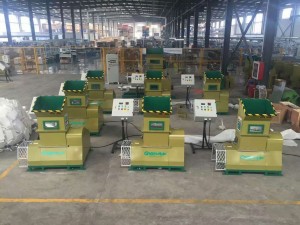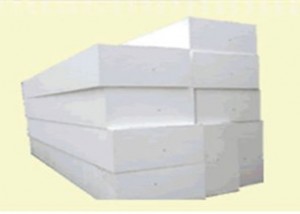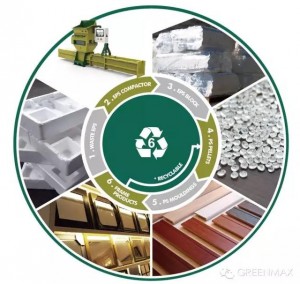Polystyrene foam because of its light weight, shock-absorbing, difficult to absorb moisture, easy to molding, low price and other characteristics, are widely used in household appliances, instruments, arts and crafts, snack food packaging and other fragile valuables. The vast majority of packaging material are disposable, the amount of waste is huge. And because polystyrene with anti-aging, corrosion resistance and other characteristics, can not be degraded and disappear on their own, thus causing increasingly serious environmental pollution. In terms of recycling polystyrene foam, in previous years, the main processing methods are producing coatings, adhesives with waste polystyrene foam, extrusion granulation and cracking monomer recycling methods. In recent years, there are a lot of people put a lot of research, and put forward many new ways.
Styrofoam recycling: change the shape and structure of collected plastic packaging, without changing its physical and chemical properties. For plastic packaging materials recycling, and ultimately through technology and process to get recycled plastic pellets.
Technical principle: waste plastics are directly crushed during molding or granulation, according to the situation, adding a certain amount of new resins, then made recycled polystyrene granules. INTCO used high quality EPS recycling GREENMAX machine to process waste styrofoam, the method is economical and efficient.

Three kinds of recycling methods:
1. Do not need sorting, cleaning and other pre-treatment, directly plastics molding after crushing. Mainly used for packaging products production process scrap and defective products, they can be fed directly into the hopper with the new material at the same time, does not require any pre-processing. This method can also be used for some broken once used, but very clean.
2. The method needs sorting, cleaning and other pre-treatment. This is mainly for those contaminated ingredients, more plastic packaging materials and products. First, washed the recovered crude material. After washing and drying, granulated or direct molded plastics. This method is generally the object of plastic packaging waste from different channel, various containers, bags, film sheets and so on.
3. Any special pre-treatment and recycling. Such as EPS foam products, bulky and inconvenient transportation, storage, using GREEENMAX EPS recycling machine to compress or melt polystyrene, therefore, to conduct preliminary degassing and reduced its volume.
Polystyrene foam (EPS) recycling method: polystyrene foam (EPS) is widely used, and often are one-time use, coupled with its light weight, bulky and hard degradation and other reasons, so that it is caused by the white pollution problems have become increasingly prominent. Therefore, to carry out its recycling research has important practical significance.

Currently, main EPS recycling procedure comprises:
1) Melt extrusion method to produce recycled polystyrene raw materials;
2) Thermal decomposed styrene monomer recovery;
3) Direct crushed and granulated, adding into new material and reuse;

New ways of polystyrene foam (EPS) recycling:
1, The production of flame retardants. It was recovered polystyrene foam cleaning, dissolved in an organic solvent and dried with liquid bromine therewith obtained by reacting brominated polystyrene flame retardants. Compared with other organic flame retardants, brominated polystyrene in the combustion process does not release dioxins and other carcinogens, it is a good performance of flame retardant. Brominated polystyrene flame retardant prepared by this process and its performance can be comparable merchandise brominated polystyrene flame retardant.
2, The production of the impact plastic. In recent years, Beijing and other places where foam recycling unit successfully prepared polystyrene pellets, but the pellets were recovered crisp, color and transparency are far less common transparent polystyrene. It is necessary to be modified to improve its performance. Someone with a linear SBS or SBS / CaCO3 composite toughening of polystyrene foam recycling toughening modification. It was found that, SBS polystyrene has good compatibility and dispersion, adding an appropriate amount of such toughening agents not only make the impact strength of recycled polystyrene has been greatly improved, but also can improve the blend moldability.
3, The production of lightweight building insulation materials. The waste polystyrene foam particles were broken into pieces smaller than 20mm in diameter, then with cement and perlite powder mixing, even the laying of conservation for 3 days on the roof, natural dry after leveling with cement mortar to its top, thereby producing concrete roof insulation. The roof is fully in line with JGJ26-95 “Energy conservation design standard” requirement, has a low cost, effective insulation, light weight, etc., not only achieve the effect of building energy efficiency, but also to achieve the purpose of recycling polystyrene foam .
4, Physical regenerated. The method of recycling previously have a common drawback is that raw materials must be clean, otherwise it will give cleaning, sorting, cause great difficulties in separating and other preparatory work. It was crushed into the Styrofoam pellets, incorporation of organic solvent-soluble binder filled, and then re-molded at room temperature, no solvent, no heating, nor do they need to clean raw materials, sub sorting, separation, simple, energy-saving and pollution-free characteristics. The process can be used to prepare a waste polystyrene foam insulation materials, building materials.
Recycling waste polystyrene foam is an effective way of handling municipal solid waste white pollution”. While addressing the pollution, to achieve the reuse of resources. Technology development and research to waste polystyrene foam recycling in waste recycling industry is formed, thereby forming a virtuous cycle of ecological, it is very necessary to maintain sustainable economic development.